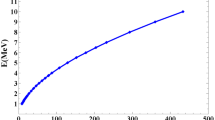Abstract
Background
At present, the highest spatial resolution of a fast neutron imaging detector, mainly determined by the range of secondary particles generated by fast neutrons, is about hundreds of microns. In view of the above inherent spatial resolution limitation, a capillary-based scintillation detector that can improve the spatial resolution of fast neutron imaging by recording and reconstructing the recoil proton track was developed.
Purpose
The purpose of this paper is to develop a detector for recognizing recoil proton events, reconstructing particle track and improving the position resolution with track reconstruction method to reconstruct the position of interaction.
Methods
The proposed detector consists of a 1000 × 1000 array of glass capillaries loaded with a high refractive index liquid scintillator. Each glass capillary was 10 μm in diameter and 5 cm in length. The recoil protons generated by the incident neutrons move within the detector and produce scintillation light within each capillary that they traverse. The light emitted from the capillary array can be recorded by employing an intensified CCD camera. We used Geant4 to simulate the detector performance and CERN ROOT analysis framework to record physical information of recoil proton, including position, energy deposition in each capillary and track length. Based on Hough transform, a rapid, computerized and efficient proton track reconstruction procedure was developed.
Conclusion
The recoil proton events display a continuous extended structure. The track reconstruction algorithms can reconstruct individual track precisely, and when the counting rate was relatively low, the track reconstruction results were in good agreement with simulation data. Moreover, for intensive overlap conditions, this algorithm also reconstructs periphery tracks with high rate of accuracy.











Similar content being viewed by others
References
L. Disdier, R.A. Lerche, J.L. Bourgade et al., Capillary detector with deuterated scintillator for inertial confinement fusion neutron images. Rev. Sci. Instrum. 75(6), 2134–2139 (2004)
L. Disdier, A. Rouyer, I. Lantuéjoul et al., Inertial confinement fusion neutron images. Phys. Plasmas 13(5), 056317 (2006)
I. Israelashvili, M. Cortesi, D. Vartsky et al., A comprehensive simulation study of a liquid-Xe detector for contraband detection. J. Instrum. 10(03), P03030 (2015)
L. Ballabio, G. Gorini, J. Kallne, Energy spectrum of thermonuclear neutrons. Rev. Sci. Instrum. 68(1), 585–588 (1997)
H. Brysk, Fusion neutron energies and spectra. Plasma Phys. 15(7), 611 (1973)
R.S. Woolf, U. Bravar, J.S. Legere et al., Development of a real-time fast neutron imaging telescope (FNIT) for the detection of SNM, in IEEE Conference on Technologies for Homeland Security (IEEE), pp. 133–138
U. Bravar, P.J. Bruillard, E.O. Flueckiger et al., Imaging solar neutrons below 10 MeV in the inner heliosphere, in Solar Physics and Space Weather Instrumentation. (International Society for Optics and Photonics, 2005), pp. 5901–59010I
A. Breskin, I. Israelashvili, M. Cortesi et al., A novel liquid-Xenon detector concept for combined fast-neutrons and gamma imaging and spectroscopy. J. Instrum. 7(06), C06008 (2012)
J.M. Ryan, J.R. Macri, M.L. McConnell et al., SONTRAC: a scintillating plastic fiber tracking detector for neutron and proton imaging spectroscopy. AIP Conf. Proc. AIP 576(1), 571–574 (2001)
U. Bravar, J.R. Macri, M.L. Mcconnell et al., FNIT: the fast neutron imaging telescope for SNM detection. Proc. SPIE 6213(2), 62130G–62130G-9 (2006)
J. Peel, N. Mascarenhas, W. Mengesha et al., Development of a directional scintillating fiber detector for 14 MeV neutrons. Nucl. Instrum. Methods Phys. Res. Sect. A 556(1), 287–290 (2006)
J. Konijin, E. Kozarenko, I. Kreslo, Development of large-volume, high-resolution tracking detectors based on capillaries filled with liquid scintillator. Nucl. Instrum. Methods Phys. Res. Sect. A (Accel. Spectrom. Detect. Assoc. Equip.) 360(1-2), 7–12 (1995)
P. Annis, A. Bay, L. Benussi, N. Bruski, S. Buontempo, C. Currat, N. D’Ambrosio, R. van Dantzig, J. Dupraz, A. Ereditato, J.P. Fabre, High-resolution tracking using large capillary bundles filled with liquid scintillator. Nucl. Instrum. Methods Phys. Res. Sect. A (Accel. Spectrom. Detect. Assoc. Equip.) 449(1-2), 60–80 (2000)
P. Annis, A. Bay, D. Bonekamper et al., Tracking with capillaries and liquid scintillator. Nucl. Phys. B Proc. Suppl. 61(1002), 390–395 (1998)
I. Mor, D. Vartsky, M. Brandis et al., Fast-neutron imaging spectrometer based on liquid scintillator loaded capillaries. J. Instrum. 7(04), C04021 (2012)
I. Mor, D. Vartsky, V. Dangendorf et al., Automatic detection of recoil proton tracks and background rejection in liquid scintillator-micro-capillary-array fast neutron spectrometer. J. Instrum. 12(12), C12022 (2017)
G.F. Knoll, Radiation detection and measurement (Wiley, Hoboken, 2010)
H.F. Li, D. Pao, R. Jayakumar, Improvements and systolic implementation of the Hough transformation for straight line detection. Pattern Recogn. 22(6), 697–706 (1989)
S.A. Rodenko, A.G. Mayorov, Method for identifying low-energy antiprotons using the electromagnetic position-sensitive calorimeter of the PAMELA spectrometer. Bull. Lebedev Phys. Inst. 43(11), 323–327 (2016)
Y. Song, J. Conner, X. Zhang et al., Monte Carlo simulation of a very high resolution thermal neutron detector composed of glass scintillator microfibers. Appl. Radiat. Isot. 108, 100–107 (2016)
M. Martensson, Fast pattern recognition of ATLAS L1 track trigger for HL-LHC. SISSA (2017)
L.A.F. Fernandes, M.M. Oliveira, Real-time line detection through an improved Hough transform voting scheme. Pattern Recogn. 41(1), 299–314 (2008)
Acknowledgements
This work was supported by the National Nature Science Foundation of China (Contract No. 11805066).
Author information
Authors and Affiliations
Corresponding author
Rights and permissions
About this article
Cite this article
Song, Z., Sun, S. & Ouyang, X. A simulation study of a high-resolution fast neutron imaging detector based on liquid scintillator loaded capillaries. Radiat Detect Technol Methods 4, 153–160 (2020). https://doi.org/10.1007/s41605-020-00164-2
Received:
Revised:
Accepted:
Published:
Issue Date:
DOI: https://doi.org/10.1007/s41605-020-00164-2




